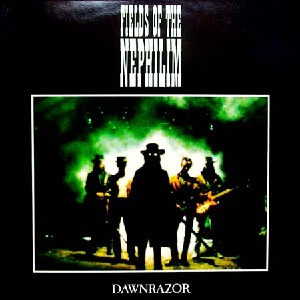Top Qs
Timeline
Chat
Perspective
Dawnrazor
1987 studio album by Fields of the Nephilim From Wikipedia, the free encyclopedia
Remove ads
Dawnrazor is the debut studio album by English gothic rock band Fields of the Nephilim. It was released on 4 May 1987, through record label Situation Two.
Remove ads
Background
The introductory track contains a sample of the Ennio Morricone theme "Man with the Harmonica" from Sergio Leone's epic 1968 western film Once Upon a Time in the West.
Critical reception
Dawnrazor was generally well-received, though the band and the album were often criticised for the perceived similarity to the work of the British gothic rock band The Sisters of Mercy.[1] Trouser Press called it "an enjoyable creation, with some great songs [...], but the Sisters' influence is so strong that it tends to overshadow the Nephs' unique qualities."[4] Dave Dickson of the British music magazine Kerrang! praises the band for the concept of "Spaghetti-metal", inspired by the characters portrayed on the screen by Clint Eastwood, but he is less warm on the execution, starting with "the plagiarising of the master musician of Spaghetti Western, Ennio Morricone" and the "truck loads of effects" used to recreate the atmosphere of the movies. For these reasons, he gave the album two different scores.[3]
Remove ads
Track listing
Summarize
Perspective
All tracks by Fields of the Nephilim, except "Intro" by Ennio Morricone
US LP has added "Preacher Man", "Power" and "Blue Water" singles but misses "Reanimator".
CD version has "Preacher Man" + 4 tracks from Italian "Returning to Gehenna EP" excluding title track but misses "Blue Water" which is available on "Revelations" compilation.
Personnel
Fields of the Nephilim
- Carl McCoy – vocals
- Peter Yates – guitar
- Paul Wright – guitar
- Tony Pettitt – bass
- Alexander Wright – drums
Production
- Bill Buchanan – producer
- Iain O'Higgins – producer on "Secrets", "Power" and "The Tower"
- Fields of the Nephilim – producers on "Laura II", "Secrets", "Power" and "The Tower"
- Martin Stansfield, Stephen Stewart – engineers
- John Fryer – mixing
- Vic Maile – mixing on "Power"
- Greg Copeland, Richard Stanley, Justin Thomas – photography
Remove ads
References
External links
Wikiwand - on
Seamless Wikipedia browsing. On steroids.
Remove ads

